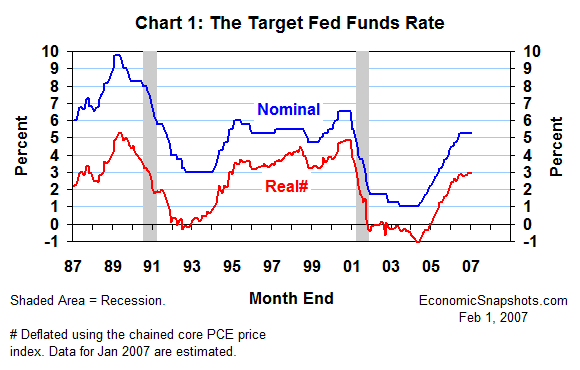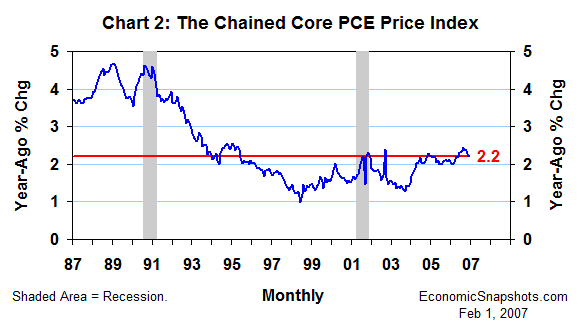
| Back to Index |
February 1, 2007 – The FOMC voted on Wednesday to leave its Fed funds target unchanged at 5.25%, continuing the “wait and see” monetary policy stance first adopted in August. Before August, the FOMC had been tightening steadily, raising its Fed funds target by a total of 425 basis points in a long string of 25 basis point increments (Chart 1).

According to the FOMC’s post-meeting policy statement, “Readings on core inflation have improved modestly in recent months, and inflation pressures seem likely to moderate over time.” As of the last FOMC meeting in December, these core inflation readings (excluding food and energy prices) were “elevated”. Thus, the FOMC seems to be feeling some cautious optimism that its longstanding forecast of a gradual slowing in core inflation may have finally begun to come true.
Today’s data shouldn’t change that view. In particular, the chained price index for personal consumption expenditures excluding food and energy (the FOMC’s preferred inflation gauge) rose by 2.2% in the twelve months through December (Chart 2). That’s probably somewhat above FOMC’s preferred inflation range. But, it’s also slightly lower than the 2.4% twelve-month trend that prevailed from August through October.

The FOMC also saw an improvement in the real economy, compared to its December meeting. “Recent indicators have suggested somewhat firmer economic growth, and some tentative signs of stabilization have appeared in the housing market.” In December, the economic indicators were “mixed”, with a “substantial cooling” in the housing market.
As before, the FOMC continues to forecast a “moderate” trend in economic growth “over coming quarters”. The FOMC majority also continues to believe that – given enough time – this subdued trend in real economic growth will eventually curb the economy’s inflationary pressures, without further Fed tightening.
However, the FOMC statement’s continuing emphasis on the economy’s inflation risks suggests that the FOMC remains more inclined to tighten than to ease in coming months. As always, “The extent and timing of any additional firming that may be needed to address these risks will depend on the evolution of the outlook for both inflation and economic growth, as implied by incoming information.”
Bottom line: With the U.S. economy still evolving in line with the FOMC's forecast, the outlook continues to favor a long stretch of unchanged U.S. monetary policy.
Suzanne Rizzo
Note: In contrast to the FOMC’s prior meetings in August, September, October and December, Wednesday’s policy vote was unanimous. At each of those prior meetings, Richmond Fed President Lacker voted against the decision to leave U.S. monetary policy unchanged, saying that he would prefer to tighten.
We don’t know how Lacker would have voted this month. As dictated by the FOMC’s annual rotation schedule, he was replaced by Boston Fed President Cathy Minehan as an FOMC member this year.
As a rule, all of the Fed’s twelve Reserve Bank Presidents attend all of the FOMC’s policy meetings and participate in the policy discussions. But, only five of them are actually FOMC members and entitled to cast a vote. This membership is determined by a “somewhat complicated” rotation structure, with changes implemented annually on January 1.